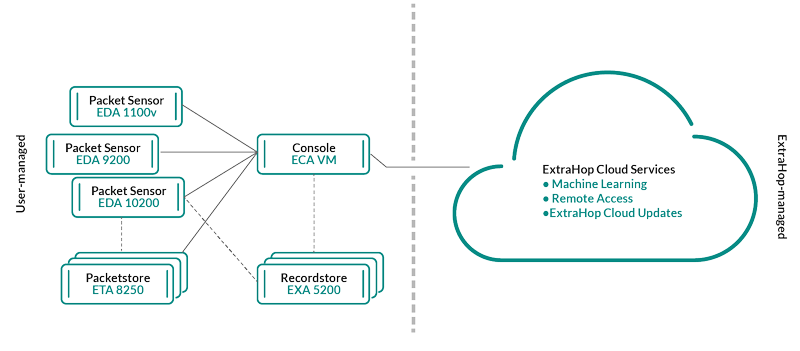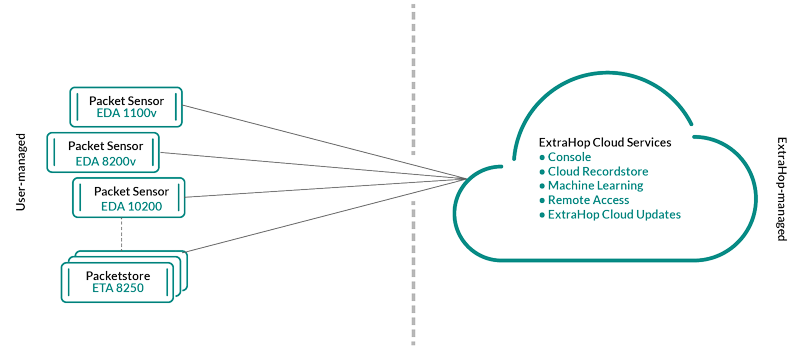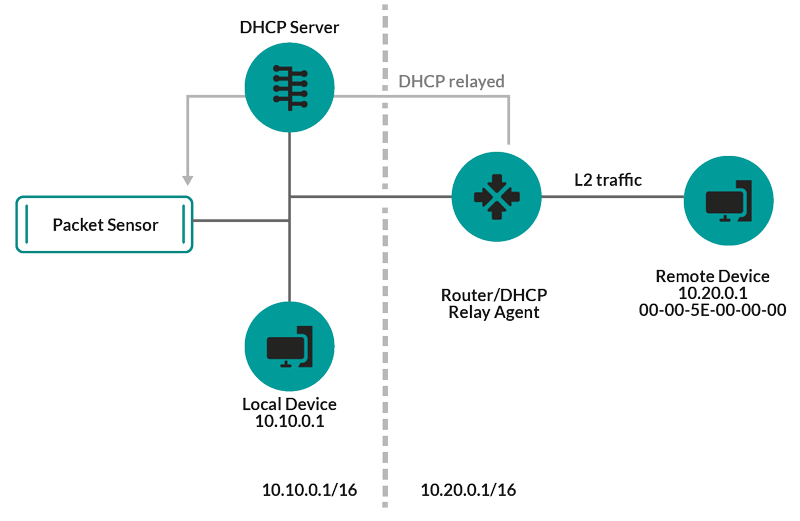Introduction to the ExtraHop system
The ExtraHop system provides a comprehensive network detection and response solution for security threats and IT operations. You can monitor how services and devices interact with each other and how transactions flow across the data link layer (L2) to the application layer (L7) in your network. You can also perform threat hunting to look for indicators of compromise within network traffic.
This guide explains how the ExtraHop system collects and analyzes your data and how the core system components and functionalities help you access detections, metrics, transactions, and packets about the traffic on your network. Each section also provides links to additional relevant resources about the feature.
Platform Architecture
The ExtraHop system is customized with modular components that combine to satisfy your unique environmental needs.
Solutions
- Reveal(x) Enterprise
- Reveal(x) Enterprise is a self-managed solution that comprises sensors,
consoles, packetstores, recordstores, and access to ExtraHop Cloud
Services.

- Reveal(x) 360
- Reveal(x) 360 is a software-as-a-service (SaaS) solution that comprises
sensors and packetsores and includes a cloud-based recordstore, a console,
and access to ExtraHop Cloud Services. The type of sensors and packetstores
are determined by subscription level.

Components
Each solution offers a set of components based on your environmental needs: sensors, packetstores, recordstores, and a console for centralized management and unified data views.
- Packet sensors
- Packet sensors capture, store, and analyze metric data about your network. Multiple levels of data analysis, collection, and storage are available by sensor size. These sensors are available as physical, virtual, and cloud-based options in sizes that are based on your analysis needs.
- Flow sensors
- Flow sensors are available for Reveal(x) 360 Standard subscriptions only and exclusively collect VPC flow logs so that you can see traffic managed by AWS SaaS services.
- Packetstores
- Packetstores integrate with sensors and consoles to provide continuous packet capture and sufficient storage for deeper investigations and forensic needs. Packetstores can be deployed as standalone physical or virtual options and are included with the Ultra subscription for Reveal(x) 360.
- Recordstores
- Recordstores integrate with sensors and consoles to store transaction and flow records that can be queried from throughout the ExtraHop system. Recordstores can be deployed as standalone physical or virtual options, supported as third-party connections to Splunk or BiqQuery from Reveal(x) Enterprise, and are included in Premium and Ultra subscriptions for Reveal(x) 360.
- Consoles
- Consoles provide a browser-based interface that provides a command center
for all connected components. Consoles can be deployed as standalone virtual
or cloud-based options for Reveal(x) Enterprise and are included in
subscriptions for Reveal(x) 360.
The following table provides an overview of the options available for each solution.
-
Reveal(x) Enterprise Reveal(x) 360 Physical Virtual/Cloud Physical Virtual/Cloud Packet sensor Flow Sensor N/A N/A N/A EFC 1291v Packetstore Included with Ultra subscriptions
Recordstore N/A Included with Premium and Ultra subscriptions Console N/A N/A Included with all subscriptions
ExtraHop Cloud Services
Smart Sensor Analytics
The ExtraHop system offers a browser-based interface with tools that enable you to explore and visualize data, investigate findings in both top-down and bottom-up workflows, and customize how you collect, view, and share your network data. Advanced users can automate and script both administrative and user tasks through the ExtraHop REST API and customize data collection through the ExtraHop Trigger API, which is a JavaScript IDE tool.
At the core of the ExtraHop system is a smart sensor that captures, stores, and analyzes metric data about your network—and offers different levels of data analysis, collection, and storage based on your needs. Sensors are provisioned with storage that supports 30 days of metric lookback. Note that actual lookback varies by traffic patterns, transaction rates, the number of endpoints, and the number of active protocols.
Consoles act as a command center with connections to multiple sensors, recordstores, and packetstores that are distributed across data centers and branch offices. All Reveal(x) 360 deployments include a console; Reveal(x) Enterprise can deploy virtual or cloud variations.
Consoles provide unified data views across all your sites and enable you to sync certain advanced configurations (such as triggers and alerts) and settings (tuning parameters, analysis priorities, and recordstores).
The following sections describe the major functional components of the ExtraHop system and how they work together.
Sensor Types
The type of sensor you deploy determines the type of data that is collected, stored, and analyzed.
Wire data
Packet sensors passively observe unstructured packets through a port mirror or tap and store the data in the local datastore. The packet data goes through real-time stream processing that transforms the packets into structured wire data through the following stages:
- TCP state machines are recreated to perform full-stream reassembly.
- Packets are collected and grouped into flows.
- The structured data is analyzed and processed in the following ways:
- Transactions are identified.
- Devices are automatically discovered and classified by their activity.
- Metrics are generated and associated with protocols and sources, and the metric data is then aggregated into metric cycles.
- As new metrics are generated and stored, and the datastore becomes full, the oldest existing metrics are overwritten according to the first-in first-out (FIFO) principle.
Flow data
A flow is a set of packets that are part of a single connection between two endpoints. Flow sensors are available for Reveal(x) 360 and offer continuous network visibility based on VPC flow logs to help secure AWS environments. VPC flow logs enable you to capture information about the IP traffic going to and from network interfaces in your VPC and are recorded as flow log records, which are log events that consist of fields that describe the traffic flow. This log data enables you to search for threats with advanced machine-learning detections.
Flow logs are ingested, deduplicated, and then grouped into flows. The flows are then enriched with data (such as MAC addresses) queried from AWS EC2 APIs.
The flows are then analyzed and processed in the following ways:
- Devices are automatically discovered and classified by their activity observed over specific ports.
- Basic L2-L4 metrics are generated and aggregated into metric cycles.
- ExFlow record types are generated and published.
Metrics, Records, and Packets
ExtraHop sensors collect and store multiple depths of network interaction as metrics. Metrics are aggregated observations about endpoint interactions over time. Packetstores collect and store the raw data transferred between two endpoints as packets. Recordstores collect and store records, which are structured information about transaction, message, and network flows.
You can view and query all of these interactions from individual sensors or from a console that is connected to a complex deployment of sensors, packetstores, and recordstores.
For example, when a client sends an HTTP request to a web server, here is what each data type contains:
- The packet contains the raw data that was sent and received in the interaction.
- The related record contains the time-stamped metadata about the interaction: when the request happened, the IP address of the client and server, the requested URI, any error messages.
- The related metric (HTTP Requests) contains an aggregate of that interaction with other observed interactions during the specified time period, such as how many requests occurred, how many of those requests were successful, how many clients sent requests, and how many servers received the requests.
Both metrics and records can be customized to extract and store specific metadata with JavaScript-based triggers. While the ExtraHop system has over 4600 built-in metrics, you might want to create a custom metric that collects and aggregates 404 errors from only critical web servers. And, you might want to maximize your record storage space by only collecting transactions that occurred over a suspicious port.
Device discovery
After a device is discovered, the ExtraHop system begins to collect metrics based on the analysis level configured for that device. You can Find a device by their MAC address, IP address, or name (such as a hostname observed from DNS traffic, NetBIOS name, Cisco Discovery Protocol (CDP) name, DHCP name, or a custom name that you assigned to the device).
The ExtraHop system can discover and track devices by their MAC address (L2 Discovery) or by their IP addresses (L3 Discovery). L2 Discovery offers the advantage of tracking metrics for a device even if the IP address is changed or reassigned through a DHCP request. By default, the ExtraHop system is configured for L2 Discovery.
Device IPv4 and IPv6 addresses are discovered from Address Resolution Protocol (ARP) messages, Neighbor Discovery Protocol (NDP) responses, local broadcasts, or local subnet multicast traffic. The MAC address and IP address for devices appear in search results throughout the system with the device information.
L2 Discovery
In L2 Discovery, the ExtraHop system creates a device entry for every local MAC address discovered over the wire. IP addresses are mapped to the MAC address, but metrics are stored with the device MAC address even if the IP address changes.
IP addresses observed outside of locally-monitored broadcast domains are aggregated at one of the incoming routers in your network. If a device sends a DHCP request through a router acting as a DHCP relay agent, the ExtraHop system detects and maps the IP address to the device MAC address. If the IP address changes for the device with a subsequent request through the DHCP relay agent, the ExtraHop system updates its mapping and continues to keep track of the device metrics by the MAC address.
Both MAC address and IP address are discovered for the remote device.

If a DHCP relay agent is not configured, remote devices can be discovered by their IP addresses through Remote L3 Discovery.
L3 Discovery
In L3 Discovery, the ExtraHop system creates and links two entries for each local discovered device: an L2 parent entry with a MAC address and an L3 child entry with IP addresses and the MAC address.
Here are some important considerations about L3 discovery:
- If a router has proxy ARP enabled, the ExtraHop system creates an L3 device for each IP address that the router answers ARP requests for.
- If you have a proxy ARP configured in your network, the ExtraHop system might automatically discover remote devices.
- L2 metrics that cannot be associated with a particular L3 child device (for example, L2 broadcast traffic) are associated with the L2 parent device.
Remote L3 Discovery
If the ExtraHop system detects an IP address that does not have associated ARP or NDP traffic, that device is considered a remote device. Remote devices are not automatically discovered, but you can add a remote IP address range and discover devices that are outside of the local network. A device entry is created for each IP address that is observed within the remote IP address range. (Remote devices do not have L2 parent entries.)
Only the IP address is discovered for the remote device.

Here are some recommendations about when to configure Remote L3 Discovery:
- Your client devices are on a network segment that is not directly tapped.
- Your organization has a remote office without an on-site ExtraHop system but users at that site access central data center resources that are directly monitored by an ExtraHop system. The IP addresses at the remote site can be discovered as devices.
- A cloud service or other type of off-site service hosts your remote applications and has a known IP address range. The remote servers within this IP address range can be individually tracked.
VPN Discovery
VPN Discovery enables the ExtraHop system to correlate the private, RFC-1918 IP addresses assigned to VPN clients with their public, external IP addresses. This enriched visibility into north-south traffic reduces barriers when investigating security incidents and performance issues that involve external VPN clients. (This feature requires a VPN gateway that is manually assigned by the user.)Software frame deduplication
The ExtraHop system removes duplicate L2 and L3 frames and packets when metrics are collected and aggregated from your network activity by default. L2 deduplication removes identical Ethernet frames (where the Ethernet header and the entire IP packet must match); L3 deduplication removes TCP or UDP packets with identical IP ID fields on the same flow (where only the IP packet must match).
The ExtraHop system checks for duplicates and removes only the immediately-previous packet both on the flow (for L3 deduplication) or globally (for L2 deduplication) if the duplicate arrives within 1 millisecond of the original packet.
By default, the same packet traversing different VLANs is removed by L3 deduplication. In addition, packets must have the same length and the same IP ID, and TCP packets also must have the same TCP checksum.
L2 duplication usually only exists if the exact same packet is seen through the data feed, which is typically related to an issue with port mirroring. L3 duplication is often the result of mirroring the same traffic across multiple interfaces of the same router, which can show up as extraneous TCP retransmissions in the ExtraHop system.
The System Health page contains charts that display L2 and L3 duplicate packets that were removed by the ExtraHop system. Deduplication works across 10Gbps ports by default and across 1Gbps ports if software RSS is enabled. L3 deduplication currently is supported only for IPv4, not IPv6.
Threat Detection
The ExtraHop system offers both machine-learning and rules-based detections that identify active or potential threats, network weaknesses that are vulnerable to exploits, and suboptimal configurations that can degrade network performance.
Additionally, charts, visualizations, and device activity maps enable proactive threat hunting.
Detection Tuning
Reduce noise and surface only critical detections by adding details about your network that help identify known parameters such as trusted domains and vulnerability scanners.Additionally, you can create tuning rules that hide specific detections or participants and further reduce unwanted noise.
Network Locality
By default, any device with an RFC1918 IP address (included in a 10/8, 172.16/12, or 192.168/16 CIDR block) is classified on the system as an internal device.However, because some network environments include non-RFC1918 IP addresses as part of their internal network, you can change the internal or external classification for IP addresses from the Network Localities page.
Threat Intelligence
The ExtraHop system includes a curated threat intelligence feed that is updated through the cloud as new threats are discovered. You can also add threat collections from a third-party or through partner integrations with ExtraHop Reveal(x) 360.Threat Briefings
Threat briefings provide information about imminent threats that are targeting networks. Updated detections, targeted record and packet queries, and affected devices are presented as a starting point for your investigation, accessed from the Security Overview page.Integrations
Reveal(x) 360 provides several third-party integrations that can enhance detection and response management and provide better visibility into network traffic.- Microsoft Protocol Decryption
- Enable decryption of Microsoft protocol traffic and improve detection of security attacks within your Microsoft Windows environment. ExtraHop Reveal(x) 360 synchronizes encryption keys with Windows domain controllers to decrypt and analyze network traffic over protocols such as LDAP, RPC, SMB, and WSMan.
- CrowdStrike
- Import threat intelligence from CrowdStrike Falcon X into the ExtraHop system to detect and annotate indicators of compromise in your environment. You can also easily navigate from assets in the ExtraHop system that are running CrowdStrike to the CrowdStrike Falcon console.
- Microsoft 365 (Beta)
- Import Microsoft 365 and Azure Active Directory detections and events into the ExtraHop system. You can also monitor Microsoft 365 metrics in built-in dashboards and view risk event details in records.
- Splunk
- Export and view ExtraHop detections in your Splunk SIEM.
- QRadar
- Export and view ExtraHop detections in your QRadar SIEM.
Thank you for your feedback. Can we contact you to ask follow up questions?